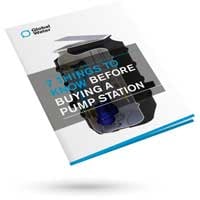Primary, secondary and tertiary treatment techniques vary from wastewater and stormwater.
 Above: Stormwater discharge to council drainage system. Image credit: Unknown
Above: Stormwater discharge to council drainage system. Image credit: Unknown
The levels of hydrocarbons, pollutants and bacteria vary in wastewater and stormwater. Due to these differences, the treatment train for wastewater and stormwater will vary.
Our Global Water team break it down, so you have a comprehensive understanding of the requirements surrounding primary, secondary and tertiary treatment of stormwater.
Primary treatment of stormwater
Initially, the gross pollutant trap (GPT) removes all large debris and trash. GPTs act as the first line of defense in the treatment train and are designed to ensure the longevity of the subsequent treatment stages. The GPT focuses on the physical process of filtration, which includes, physical screening, hydrodynamic separation and removal of sedimentation.
Through an effective primary treatment step, and initial filtration process, you are reducing maintenance of the overall treatment train, protecting assets downstream, reducing sediment load and maintaining a steady flow of water.
Secondary treatment of stormwater
The secondary treatment stage targets fine particle sedimentation, settling chambers and oil removal. This stage aims to achieve clean water quality and is responsible for water polishing – where the oil and water are successfully separated.
Secondary treatment systems commonly use coalescing filters for oil/water separation.
Environmental guidelines state that “a person must not discharge a class 1 pollutant into any waters or onto land in a place from which it is reasonably likely to enter waters” (Environment Protection [Water Quality] Policy 2015). Class 1 pollutants include oil grease or lubricants, petroleum products, rubbish and litters (amongst other elements).
The European Standard EN858-1:2002 effectively tests the removal of these Class 1 pollutants. As Australia is yet to develop their own guidelines, stormwater treatment products are graded against the European standards for effectiveness. To achieve this EN858 approval, water quality discharge should achieve “no visible trace” of Class 1 pollutants (<5mg/L).
As some treatment trains end at this second stage, water quality must comply with the Environment Protection Act by treating or removing Class 1 pollutants. From this stage, water can be effectively returned to the environment for biological treatment (wetlands, read further below).
Tertiary treatment of stormwater
During this final treatment stage, enhanced sedimentation and filtration, biological uptake, absorption and chemical filtration occurs. It aims to remove nutrients and dissolved heavy metals. Using a range of advanced technology, including a variety of chemical processes, minuscule particles and attached pollutants are removed.
This tertiary stage is the final step in the stormwater treatment train and is designed to improve the water quality. It is generally implemented for water filtration and to provide an alternative source of water supply.
Tertiary stormwater treatment can occur through these means or through natural processes.
Wetlands as Stormwater Treatment
 Above: Wetlands in South Australia offering natural water treatment and enjoyable green spaces.
Above: Wetlands in South Australia offering natural water treatment and enjoyable green spaces.
Image Credit: Unknown
Wetlands feature three parts that work cohesively to filter stormwater and protect from flooding, these include:
- Inlet zone - this acts as a sediment basin that removes coarse sediment
- Macrophyte zone – a shallow area planted with aquatic plants, which removes fine particles and dissolved pollutants. This is the main part of the wetland.
- High flow bypass channel – This channel allows excess water flow around the wetland without damaging the plants.
Wetlands work on three levels of filtration, physical, biological, chemical uptake and pollutant transformation:
- Physical filtration: Plants are used to capture fine particles and trap a proportion of absorbed pollutants attached to sediment.
- Biological/Chemical Uptake: Microorganisms, referred to as biofilms, grow on the surface of plants and absorb and trap pollutants. They enhance the sedimentation and adhesion to fine suspended particles.
- Pollutant Transformation: Wetlands can effectively transform pollutants in stormwater through - regular wetting and drying cycle stabilises, microbial processes converting pollutants like ammonium and nitrate and ultraviolet (UV) treatment.
This is just one example of how stormwater can be treated in an ecological way.
For more information on stormwater treatment, or to find products suitable for your treatment train, contact our Global Water team.
We have products to suit treatment requirements, from primary and secondary treatment, and can advise on tertiary treatment if required.
Tags: Wastewater, Stormwater




